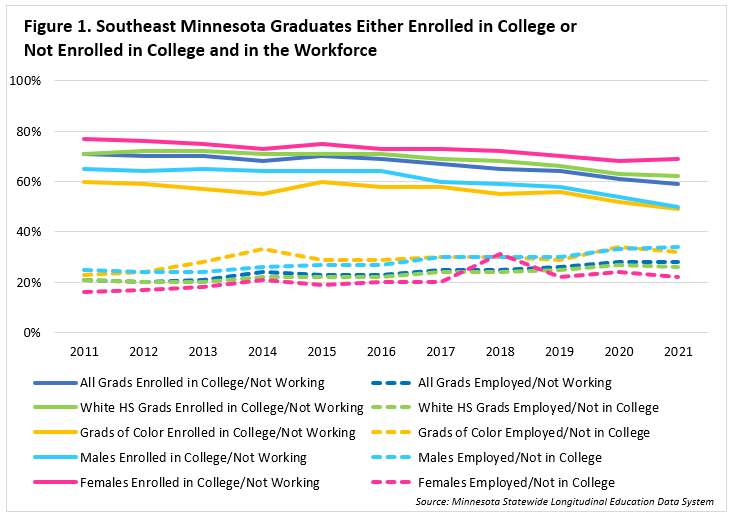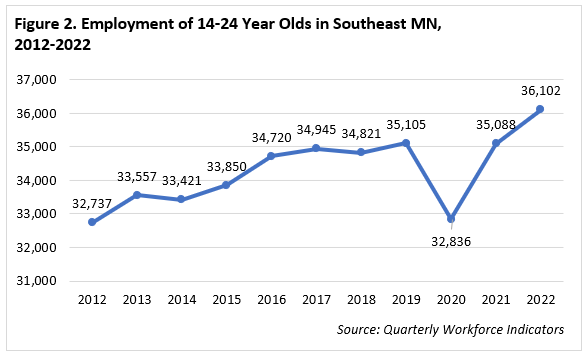
by Amanda O'Connell
June 2023
With a strong and growing economy, more and more recent high school graduates in Southeast Minnesota are choosing not to pursue a four-year college degree and instead are entering the workforce. The tight labor market is pushing up wages and pushing down educational requirements for some positions, creating a favorable job market for recent grads. The decline in the percentage of recent high school grads immediately going on to college is a trend throughout Minnesota and the country as a whole.
Until the COVID-19 pandemic in 2020, Southeast Minnesota's economy was growing at a rapid pace, adding 19,891 jobs and 260 net new firms from 2009 to 2019. Then from 2019 to 2020, Southeast employers lost 13,687 jobs. Following this decline, the region showed signs of recovery from 2021 to 2022 with an increase of 1,869 jobs and a gain of 458 firms. By 2022, Southeast had 239,872 jobs and 13,373 firms, demonstrating ongoing progress in restoring pre-pandemic employment levels.
According to DEED's Location Quotient Tool, Southeast Minnesota's employment concentration was above the state average in several industries during 2022. Health Care & Social Assistance is the most distinguishing industry in the region, with nearly 65,500 jobs and a location quotient of 1.6. Other competitive industries in Southeast include Agriculture, Forestry, Fishing, & Hunting (with a location quotient of 1.7), Manufacturing (1.3), Utilities (1.2), Accommodation & Food Services (1.1), and Retail Trade (1.1) (see Table 1).
| Table 1. Industry Statistics in Southeast Minnesota, 2022 | |||||
|---|---|---|---|---|---|
| Industry | Employment (Number of Jobs) | Number of Firms | Total Payroll | Avg. Annual Wage | Location Quotient |
| Total, All Industries | 239,872 | 13,373 | $14,675,198,148 | $61,152 | 1.0 |
| Health Care & Social Assistance | 65,463 | 1,892 | $5,278,818,560 | $80,600 | 1.6 |
| Manufacturing | 36,031 | 662 | $2,499,066,963 | $69,316 | 1.3 |
| Retail Trade | 26,238 | 1,587 | $883,831,220 | $33,644 | 1.1 |
| Educational Services | 19,406 | 276 | $1,016,791,652 | $52,468 | 1.0 |
| Accommodation & Food Services | 18,997 | 1,144 | $414,582,824 | $21,788 | 1.1 |
| Public Administration | 10,902 | 365 | $677,786,752 | $62,140 | 1.0 |
| Construction | 9,949 | 1,498 | $669,452,952 | $67,028 | 0.8 |
| Transportation & Warehousing | 7,908 | 618 | $438,660,466 | $55,380 | 0.8 |
| Administrative Support & Waste Mgmt. Services | 7,369 | 528 | $398,682,744 | $54,080 | 0.7 |
| Wholesale Trade | 6,582 | 499 | $518,891,081 | $78,832 | 0.6 |
| Other Services | 6,369 | 1,393 | $218,514,660 | $34,268 | 0.9 |
| Management of Companies | 4,296 | 58 | $451,871,109 | $105,196 | 0.6 |
| Finance & Insurance | 4,166 | 686 | $325,167,600 | $78,104 | 0.3 |
| Arts, Entertainment, & Recreation | 3,897 | 270 | $108,703,096 | $27,820 | 0.7 |
| Professional, Scientific, & Technical Services | 3,647 | 818 | $247,052,865 | $67,860 | 0.3 |
| Agriculture, Forestry, Fishing & Hunting | 3,238 | 411 | $136,979,935 | $42,172 | 1.7 |
| Information | 2,485 | 209 | $141,973,663 | $57,148 | 0.6 |
| Real Estate & Rental & Leasing | 1,390 | 393 | $61,129,630 | $43,888 | 0.5 |
| Utilities | 1,347 | 49 | $175,094,808 | $129,948 | 1.2 |
| Mining | 185 | 22 | $12,145,568 | $64,324 | 0.4 |
| Source: DEED Quarterly Census of Employment & Wages | |||||
Employers in the region are seeking individuals with diverse skill sets and educational backgrounds. According to DEED's Job Vacancy Survey, there were 19,304 job vacancies in Southeast Minnesota in the second quarter of 2022. Among these vacancies, 75% required a high school diploma or equivalent to start, 15% required vocational training or an associate's degree, and just 10% required a bachelor's degree or higher.
This data emphasizes the availability of employment opportunities for workers of varying education levels and skill sets, rendering the labor market accessible to a wide range of individuals. Recent high school graduates, in particular, have numerous opportunities to enter the workforce or pursue alternative educational paths, some paid for by an employer or a union, that do not require a four-year degree. There are numerous advantages to entering the workforce after high school and pursuing vocational training, technical training, or apprenticeships. It provides individuals with valuable work experience, a steady income, and practical skills and knowledge applicable to future career goals.
Data indicates that recent high school graduates in the region are increasingly choosing to enter the workforce rather than pursuing a four-year degree. The Minnesota Statewide Longitudinal Education Data System (SLEDS) shows a shift in trends of after high school plans among recent graduates in Southeast Minnesota.
As seen in Figure 1, since 2011 the percent of high school graduates immediately entering the workforce has increased by 7 percentage points, while the percent of graduates enrolling in college in the fall has decreased by 12 percentage points. It is crucial to emphasize that the two groups, high school graduates immediately entering the workforce and those enrolling in college in the fall, are mutually exclusive. This implies that individuals enrolled in college are not reflected in the workforce data, despite the fact that many college students do work. Importantly, these trends are not limited to any particular demographic. The data reveals similar patterns across race, ethnicity and gender.
Among recent graduates in Southeast identifying as White, the college enrollment rate has experienced a decline of 9 percentage points, while the workforce entry rate has displayed a 5 percentage point increase. Likewise, students of color in the region have experienced comparable shifts, with a notable 11 percentage point decrease in college enrollment and a significant 9 percentage point increase in entering the workforce since 2011.

Notably, the trends also manifest when considering gender. Males in Southeast have witnessed a substantial 15 percentage point decrease in college enrollment, while simultaneously experiencing a 9 percentage point increase in entering the workforce. Comparatively, females in the region have observed an 8 percentage point decline in college enrollment, alongside a 6 percentage point rise in workforce entry.
Numerous factors contribute to the increasing trend of entering the workforce and the decreasing trend of college enrollment. One significant factor is the escalating cost of college education.
Data from the Minnesota Office of Higher Education reveals that tuition and fees have consistently risen over the past 15 years. Since 2009-2010, there has been an average annual increase in tuition of 3% for 4-year Minnesota State Universities and an annual 3.9% jump for private four-year colleges in Minnesota1. This upward trajectory in college costs has made higher education less financially feasible for many individuals, prompting them to consider alternative paths such as entering the workforce or enrolling in trade schools or apprenticeships directly after high school.
In addition, Minnesota's tight labor market has encouraged some employers to reduce educational requirements, eliminating the need for post-secondary education for some positions. Some Minnesota high schools are also raising awareness about career options that provide on-the-job-training so young people can earn while they learn right out of high school.
In Southeast Minnesota, there are many job opportunities for high school graduates seeking to enter the workforce immediately after graduation. As noted, approximately 75% of the job vacancies observed in the second quarter of 2022 required a high school diploma or equivalent to get started. Among the various occupational groups, several stand out for their high percentage of jobs with minimal educational requirements.
In occupations such as Food Preparation & Serving, Building & Grounds Cleaning & Maintenance, and Transportation & Material Moving, an overwhelming 99% of jobs require a high school diploma or less. Similarly, 98% of jobs in the Sales & Related occupation group require a high school diploma or less. These occupational groups offer a median wage ranging between $13.72 and $16.97 per hour.
Individuals seeking training opportunities before or while working have a range of options to choose from. For example, in Installation, Maintenance, & Repair occupations, around 75% of jobs typically require vocational training. Similarly, in Personal Care & Service occupations, approximately 64% of jobs require vocational training. In Construction & Extraction occupations, 27% can be started with vocational training and another 70% need a high school diploma or less, but offer median wages around $20 per hour(see Table 2).
| Table 2. Southeast Minnesota Job Vacancies, Qtr. 2 2022 | ||||||||
|---|---|---|---|---|---|---|---|---|
| Educational Requirements (% of vacancies) | ||||||||
| Occupation | Number of Job Vacancies | None | HS or GED | Vocational Training | Associate Degree | Bachelor's Degree | Advanced Degree | Median Wage Offer |
| Total, All Occupations | 19,304 | 55% | 20% | 10% | 5% | 7% | 3% | $16.08 |
| Food Preparation & Serving Related | 4,822 | 87% | 12% | 1% | 0% | 0% | 0% | $13.72 |
| Sales & Related | 2,248 | 88% | 10% | 0% | 1% | 1% | 0% | $14.59 |
| Transportation & Material Moving | 1,752 | 81% | 18% | 0% | 0% | 0% | 0% | $16.97 |
| Production Occupations | 1,593 | 31% | 60% | 6% | 2% | 1% | 0% | $15.96 |
| Healthcare Practitioners & Technical | 1,328 | 1% | 6% | 12% | 37% | 20% | 23% | $31.77 |
| Healthcare Support | 1,139 | 64% | 29% | 6% | 1% | 0% | 0% | $15.40 |
| Building, Grounds Cleaning & Maint. | 945 | 83% | 16% | 0% | 0% | 0% | 0% | $15.09 |
| Construction & Extraction | 924 | 26% | 42% | 27% | 4% | 0% | 0% | $19.83 |
| Office & Administrative Support | 828 | 39% | 43% | 11% | 4% | 2% | 0% | $16.86 |
| Personal Care & Service | 805 | 22% | 5% | 64% | 0% | 7% | 2% | $15.13 |
| Installation, Maintenance & Repair | 739 | 13% | 7% | 75% | 3% | 2% | 0% | $14.23 |
| Educational Instruction & Library | 490 | 3% | 6% | 10% | 3% | 71% | 6% | $20.68 |
| Management Occupations | 333 | 12% | 20% | 0% | 15% | 49% | 4% | $30.93 |
| Business & Financial Operations | 254 | 6% | 16% | 0% | 20% | 57% | 1% | $24.78 |
| Computer & Mathematical | 188 | 7% | 11% | 0% | 31% | 48% | 4% | $33.61 |
| Architecture & Engineering | 186 | 3% | 15% | 0% | 32% | 51% | 0% | $29.46 |
| Community & Social Service | 171 | 14% | 11% | 1% | 5% | 44% | 25% | $23.79 |
| Life, Physical, & Social Science | 152 | 4% | 2% | 0% | 14% | 24% | 57% | $24.51 |
| Arts, Design, Entertainment & Media | 103 | 29% | 21% | 2% | 7% | 41% | 0% | $16.24 |
| Protective Service | 100 | 7% | 71% | 1% | 15% | 6% | 0% | $19.68 |
| Legal Occupations | 50 | 0% | 0% | 0% | 81% | 12% | 6% | $20.46 |
| Internships | 25 | 31% | 8% | 12% | 10% | 22% | 17% | N/A |
| Apprenticeships | 12 | 11% | 63% | 25% | 0% | 0% | 0% | $19.26 |
| Source: DEED Job Vacancy Survey, Qtr. 2 2022 | ||||||||
To pursue vocational training, interested individuals can look to local technical colleges and organizations that offer relevant programs. For example, All Craft Exteriors, an organization located in Rochester, provides an 8-week paid training program for individuals interested in acquiring skills in home improvement and the building trades2. Such initiatives provide practical, hands-on learning experiences, allowing participants to gain valuable expertise while being compensated.
In addition to vocational training, graduates can opt to participate in apprenticeships, which offer a unique combination of on-the-job training and paid work experience. The Minnesota Department of Labor and Industry is a valuable resource for individuals seeking apprenticeships and training programs. Individuals can access a comprehensive list of available apprenticeships across various industries through their website3.

Over the past decade, Southeast Minnesota has experienced changes in its labor force. Between 2012 and 2022, the region experienced a notable increase of 11,820 individuals joining the labor force. Particularly noteworthy is the rise in young workers aged 14 to 24 years old, as depicted in Figure 2. Although the Pandemic Recession led to a temporary dip in youth employment, Southeast Minnesota has surpassed pre-pandemic levels, adding 3,365 young workers into jobs from 2012 to 2022. This resilience and rebound in youth employment highlights the region's ability to adapt and recover from challenging circumstances, paving the way for a robust and diverse workforce in Southeast Minnesota.
In sum, the current labor market in Southeast presents great opportunities for high school graduates. There is a wide array of in-demand occupations that do not require more than a high school diploma. Occupations such as Fast Food & Counter Workers, Retail Salespersons, Home Health & Personal Care Aides, Cashiers, and Laborers & Freight, Stock & Material Movers are highly sought after. The median hourly wages for these positions range from $14.11 to $19.33.
Additionally, numerous occupations requiring vocational training are in demand, including Licensed Practical & Licensed Vocational Nurses, Nursing Assistants, Automotive Service Technicians & Mechanics, Medical Assistants, and Emergency Medical Technicians & Paramedics. These occupations offer median hourly wages ranging from $18.41 to $25.46.
Overall, trends indicate that Southeast high school graduates are entering the workforce more now than in the last 10 years. This trend highlights the growing availability of opportunities for individuals pursuing alternative educational paths or entering the job market directly after high school without pursuing a four-year degree. Opting to enter the workforce or completing vocational training, technical programs, or apprenticeships allows individuals to gain valuable work experience, establish a stable income, and acquire practical skills and knowledge that can be applied to their future career aspirations.